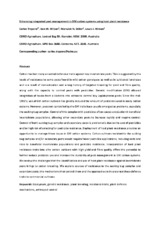Mostrar el registro sencillo del ítem
Enhancing Integrated Pest Management in GM Cotton Systems Using Host Plant Resistance
| dc.contributor.author | Trapero Ramírez, Carlos | |
| dc.contributor.author | Wilson, I.W. | |
| dc.contributor.author | Stiller, W.N. | |
| dc.contributor.author | Wilson, L.J. | |
| dc.date.accessioned | 2024-02-11T12:44:40Z | |
| dc.date.available | 2024-02-11T12:44:40Z | |
| dc.date.issued | 2016 | |
| dc.identifier.uri | http://hdl.handle.net/10396/27401 | |
| dc.description.abstract | Cotton has lost many ancestral defensive traits against key invertebrate pests. This is suggested by the levels of resistance to some pests found in wild cotton genotypes as well as in cultivated landraces and is a result of domestication and a long history of targeted breeding for yield and fiber quality, along with the capacity to control pests with pesticides. Genetic modification (GM) allowed integration of toxins from a bacteria into cotton to control key Lepidopteran pests. Since the mid-1990s, use of GM cotton cultivars has greatly reduced the amount of pesticides used in many cotton systems. However, pests not controlled by the GM traits have usually emerged as problems, especially the sucking bug complex. Control of this complex with pesticides often causes a reduction in beneficial invertebrate populations, allowing other secondary pests to increase rapidly and require control. Control of both sucking bug complex and secondary pests is problematic due to the cost of pesticides and/or high risk of selecting for pesticide resistance. Deployment of host plant resistance (HPR) provides an opportunity to manage these issues in GM cotton systems. Cotton cultivars resistant to the sucking bug complex and/or secondary pests would require fewer pesticide applications, reducing costs and risks to beneficial invertebrate populations and pesticide resistance. Incorporation of HPR traits into elite cotton cultivars with high yield and fiber quality offers the potential to further reduce pesticide use and increase the durability of pest management in GM cotton systems. We review the challenges that the identification and use of HPR against invertebrate pests brings to cotton breeding. We explore sources of resistance to the sucking bug complex and secondary pests, the mechanisms that control them and the approaches to incorporate these defense traits to commercial cultivars. | es_ES |
| dc.format.mimetype | application/pdf | es_ES |
| dc.language.iso | eng | es_ES |
| dc.publisher | Frontiers | es_ES |
| dc.rights | https://creativecommons.org/licenses/by/4.0/ | es_ES |
| dc.source | Trapero, C., Wilson, I. W., Stiller, W. N., & Wilson, L. (2016). Enhancing Integrated Pest Management in GM Cotton Systems Using Host Plant Resistance. Frontiers In Plant Science, 7. https://doi.org/10.3389/fpls.2016.00500 | es_ES |
| dc.subject | Gossypium | es_ES |
| dc.subject | Genetic resistance | es_ES |
| dc.subject | Plant breeding | es_ES |
| dc.subject | Resistance traits | es_ES |
| dc.subject | Plant defence mechanisms | es_ES |
| dc.subject | Arthropod control | es_ES |
| dc.title | Enhancing Integrated Pest Management in GM Cotton Systems Using Host Plant Resistance | es_ES |
| dc.type | info:eu-repo/semantics/article | es_ES |
| dc.relation.publisherversion | https://doi.org/10.3389/fpls.2016.00500 | es_ES |
| dc.rights.accessRights | info:eu-repo/semantics/openAccess | es_ES |

